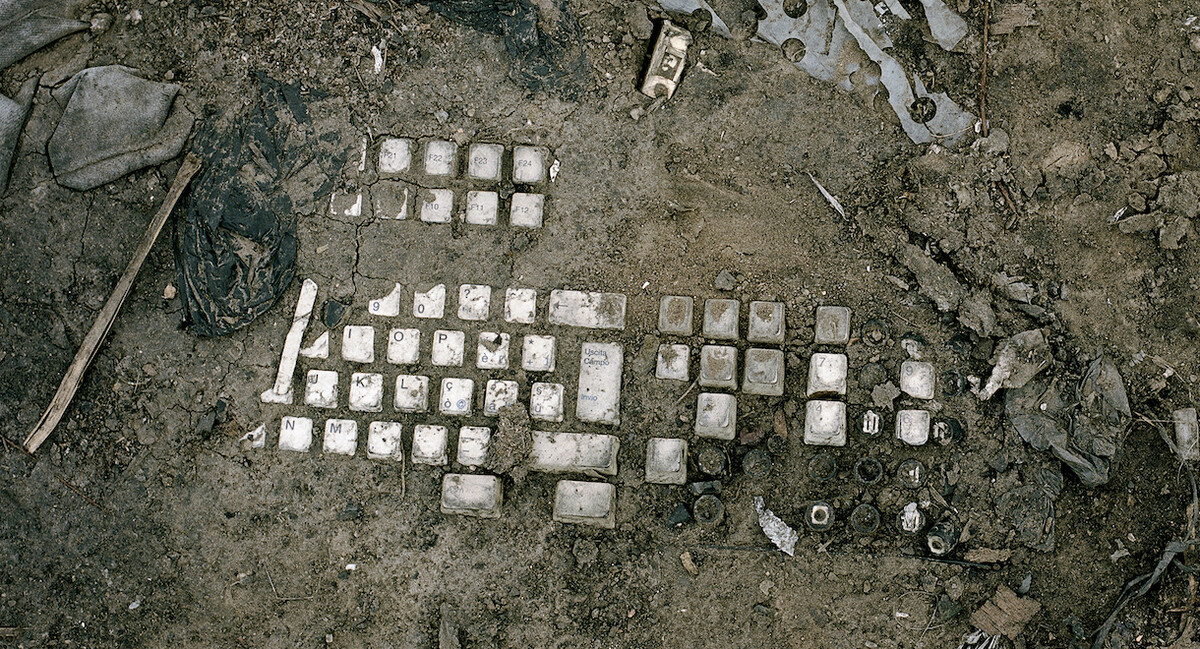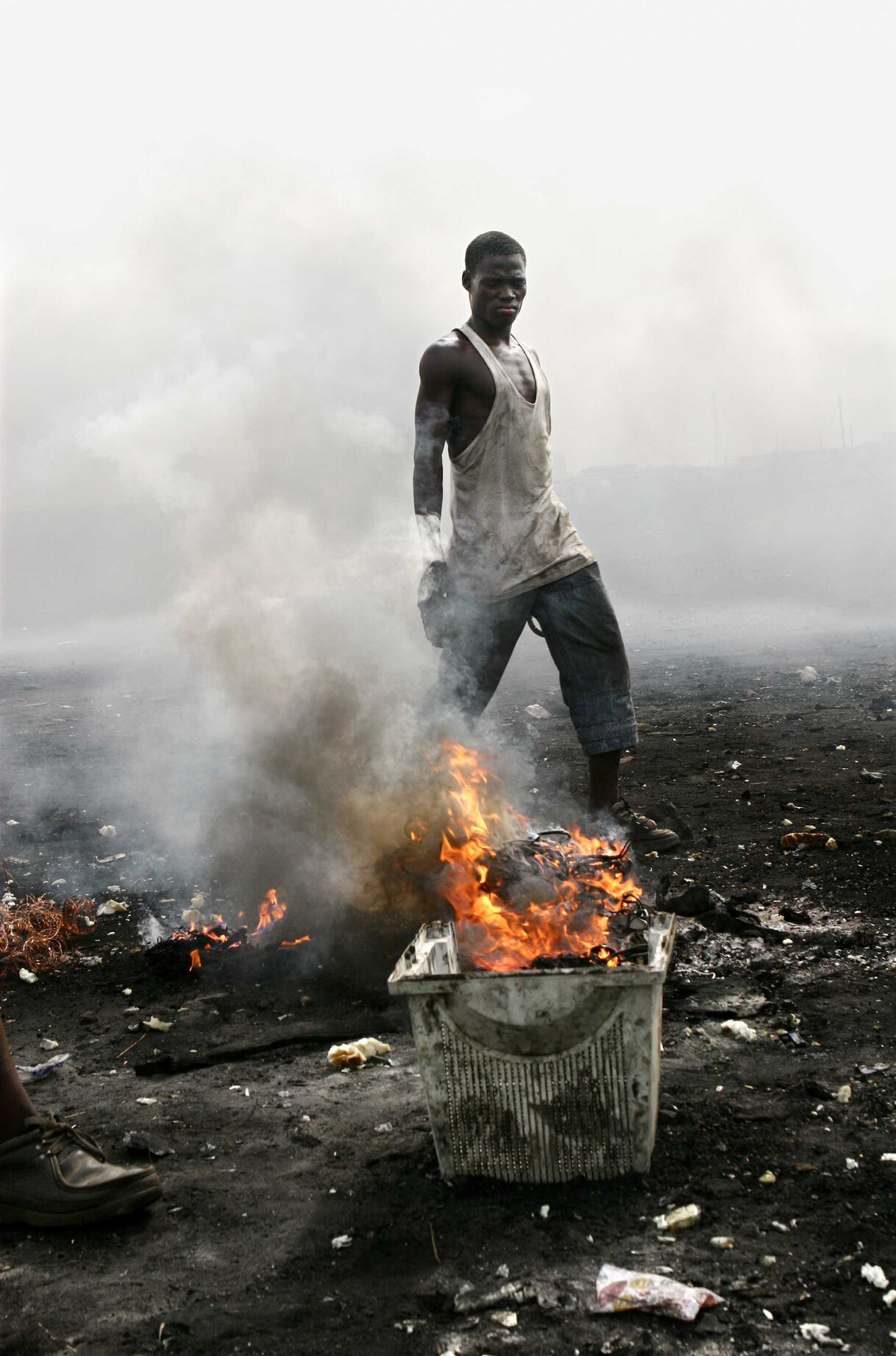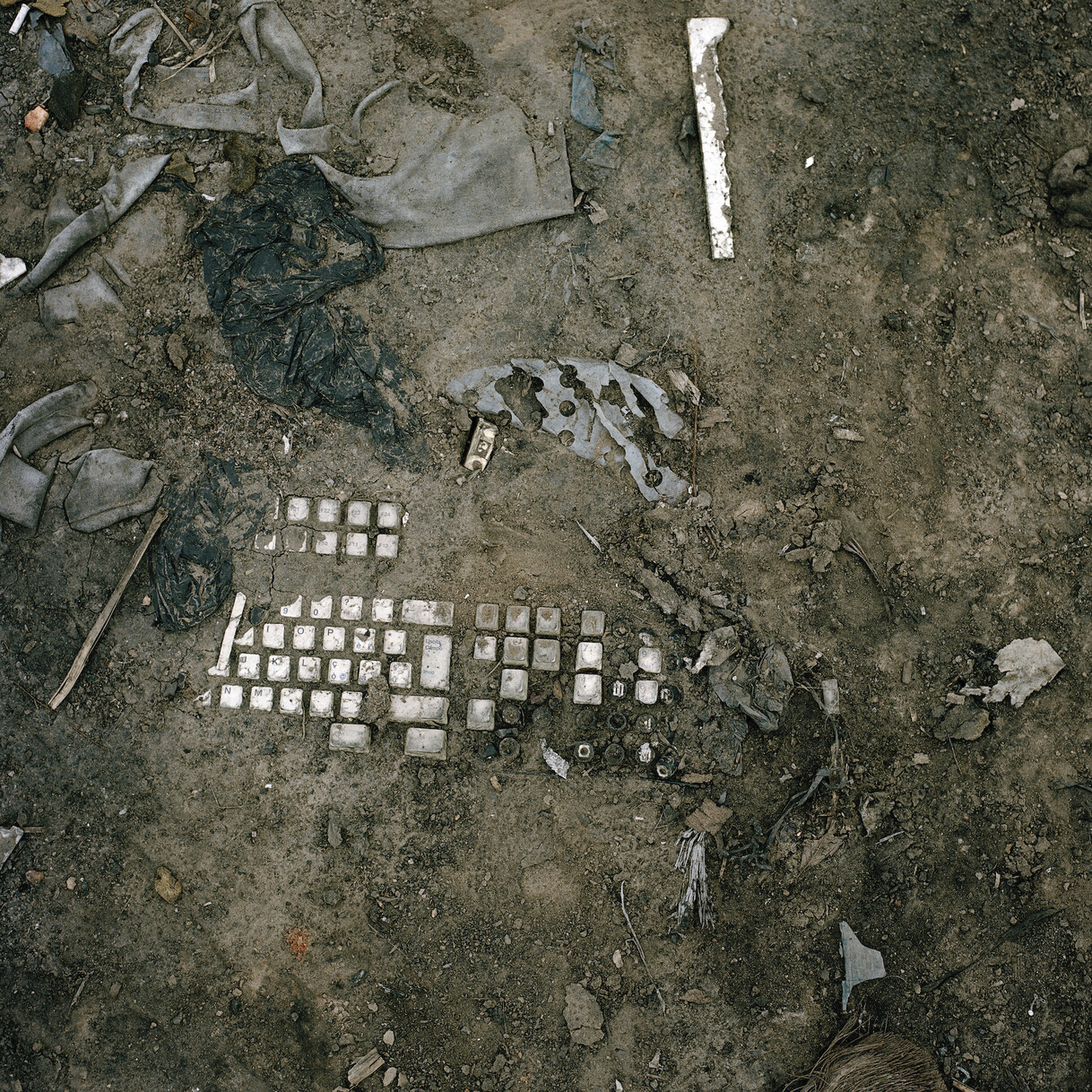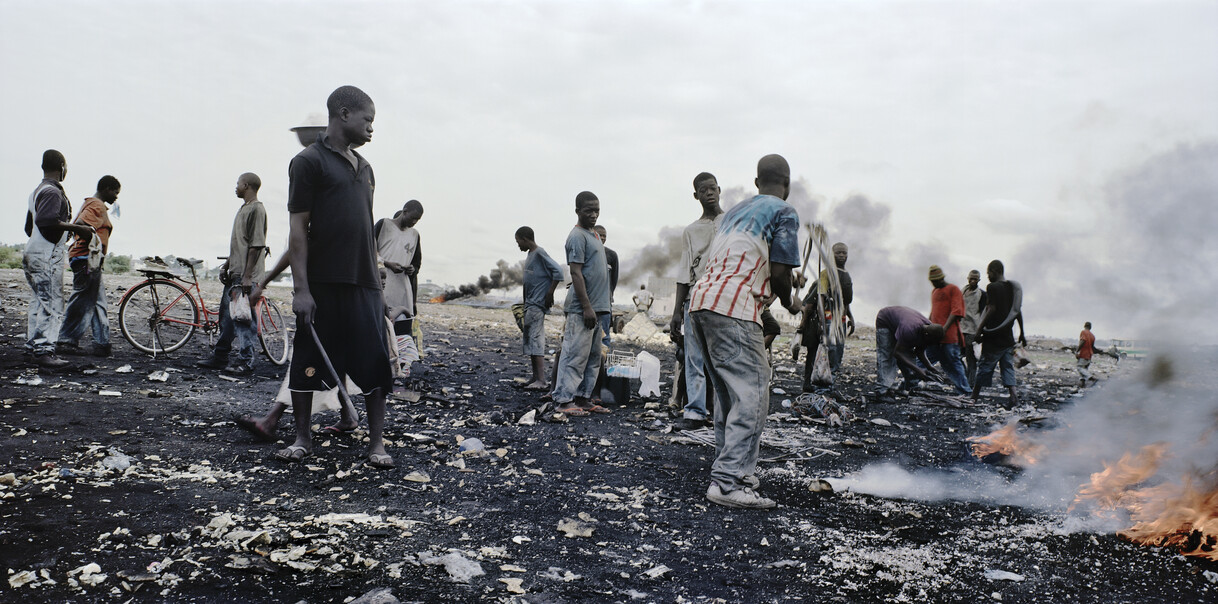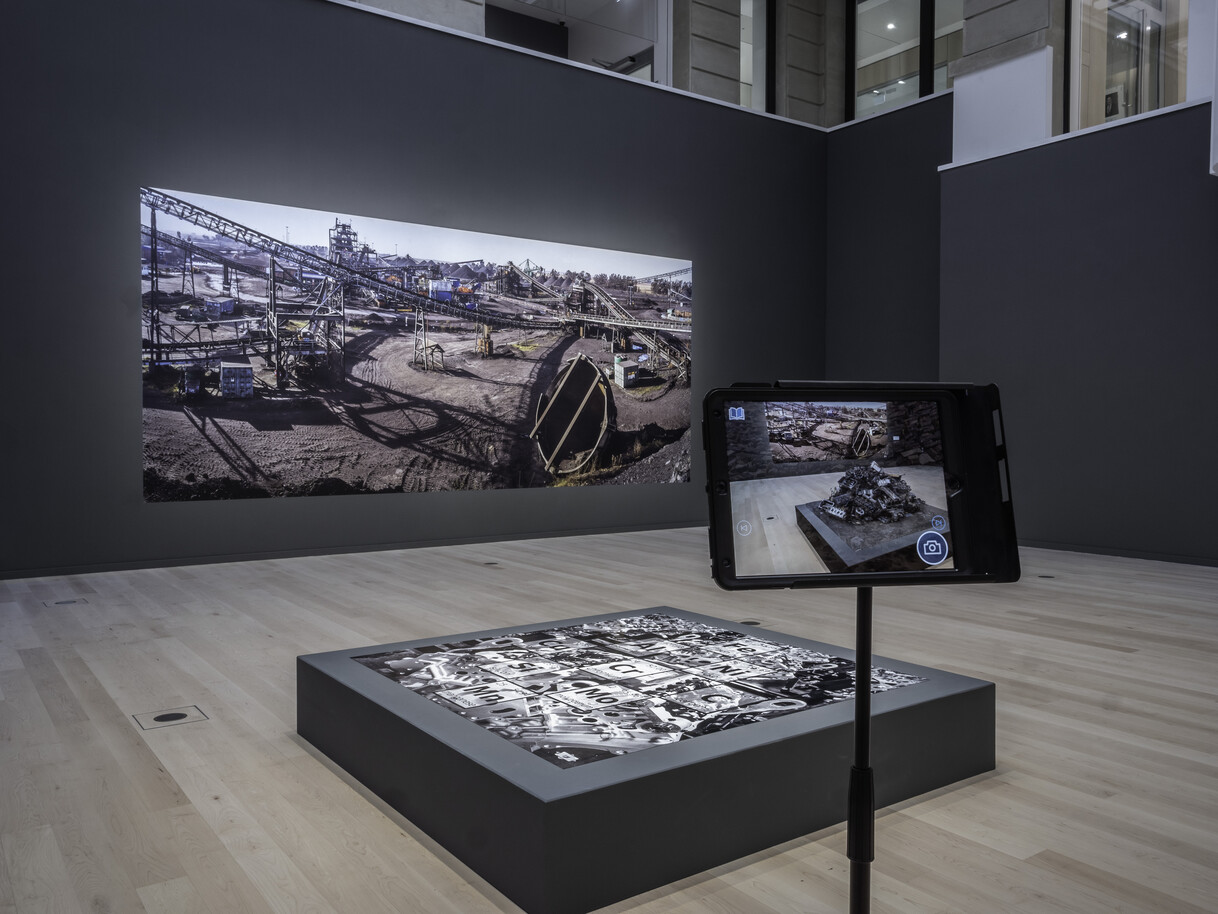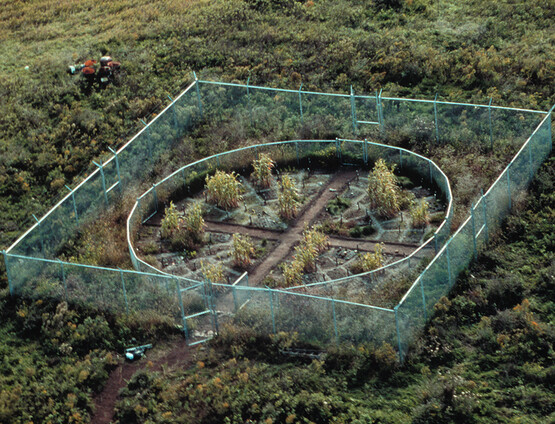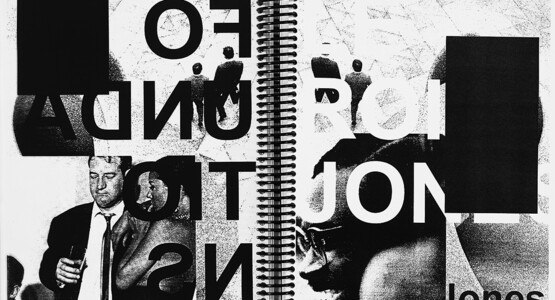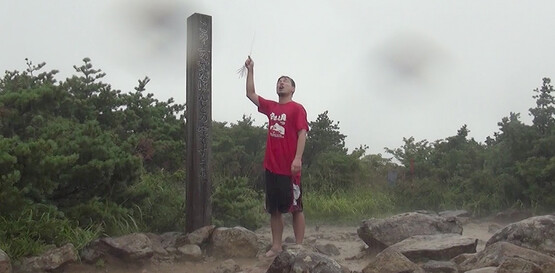Photography after Discard Studies: the case of Agbogbloshie
by Jacob Badcock • November 2022
On the night of 20th January 2008 a nation came together in celebration. Sulley Muntari, a talented midfielder for the Black Stars, the Ghana national football team, had in the ninetieth minute dispatched a powerful strike into the top corner of the goal to give Ghana a 2–1 victory over Guinea in the opening match of the 2008 Africa Cup of Nations. Muntari and his teammates danced a joyous jig. Red, gold and green glittered across the Ohene Djan Stadium (now Accra Sports Stadium), and thirty-five thousand compatriots danced with them.1 Like the rest of the world’s assembled sports media, the Burkinabe photographer Nyaba Leon Ouedraogo (b.1978) came to Accra to cover the festivities of the tournament. Instead, Ouedraogo found himself documenting a much less joyous subject: electronic waste, or e-waste pollution. In an interview with the Guardian Ouedraogo explained how, when arriving in Accra, he was taken at the insistence of his taxi driver to Old Fadama, an urban ‘slum’ situated along the Odaw River on the outskirts of the city. Old Fadama is home to some forty thousand residents, many of whom are economic migrants from the predominantly rural north of Ghana. Adjacent to Old Fadama is a fruit and vegetable market, at the fringes of which Ouedraogo came upon a ‘cemetery’ of abandoned computers that he claimed stretched across the landscape for some 10 kilometres. Unbeknownst to Ouedraogo, he had come to Agbogbloshie, the world’s most infamous e-waste ‘dump’ site.2 Ouedraogo’s anecdote regarding his first visit to Agbogbloshie is a revealing one: in fact, the scrapyard only extends to 1.5 kilometres. This exaggeration of scale is among the first of many false claims made about Agbogbloshie by photographers, pollution scientists and environmental activists, as this paper will demonstrate.3
At Agbogbloshie informal labourers, many of whom are teenagers, work to extract e-waste components, such as printed circuit boards (PCBs), central processing units (CPUs) and wires, which themselves may also contain precious and semi-precious metals, namely gold, copper, iron and aluminium.4 They also undertake repairs of used electronic equipment, which is resold and reused through a thriving second-hand technology market. The extraction of metals from e-waste is carried out through the manual disassembly of equipment to remove component parts. Most commonly, it is plastic-coated copper wires that are burned by workers. These wires contain polyvinyl chloride (PVC), which, when exposed to heat, undergoes a failed combustion reaction that releases toxic fumes into the air. Workers have also been known to burn other more materially complex component parts, such as PCBs, which are made up of glass, plastics, resin, solder and metals, and contain most of the toxicants in electronic equipment.5 The emission of pollutants from e-waste through burning has been attributed to numerous public health and environmental problems, with pollution scientists drawing a causal relationship between the contamination of local air, water and soil supplies, genetic mutations in plant and animal life as well as the occurrence of cancers, respiratory illnesses and lung failures in humans.6 Located just a few kilometres from the sports stadium, the residents of Old Fadama might well have heard the cheers of celebration when Muntari’s goal struck. No doubt, locals would have been huddled around television sets, watching the match along with the thousands in the stands: on that night, at least, their breath was not taken away by toxic fumes, but by the thumping of a football and the swooshing of net.
Ouedraogo would return to Agbogbloshie several times between 2008 and 2009. On one visit he took a picture of a waste worker named Yaw. This photograph FIG. 1, part of the series entitled The Hell of Copper (L’enfer du Cuivre), would go on to secure Ouedraogo a nomination for the Prix Pictet, a global award for photography and sustainability. Ouedraogo’s camera looks up at Yaw, who stands tall over a fire. Yaw is dressed in a dirtied vest and a pair of charred denim cut-offs. His eyes are downturned. At Yaw’s feet, there is a bundle of wires ablaze. The ground about the fire is almost black. The soil has been covered with layer after layer of dust from the continuous lighting and re-lighting of e-waste fires atop one another. A thick plume of smoke emanates from the fire, drawing our eyes to the paler light of the skies. The air pollution is visible, claustrophobic even: smoke fills the frame and the promise of clean air seems far off, unreachable, impossible. To the left of Yaw, there is a pile of copper. This is the fruit of Yaw’s labour: a few dollars’ worth of metal to be sold, refined, recycled, reused in the production of new electronic equipment and perhaps returned to Agbogbloshie once again in the form of yet more technological waste.7 Since Ouedraogo’s publication of The Hell of Copper, Agbogbloshie has become infamous as the ‘world’s largest e-waste dump site’, a false claim made repeatedly by numerous media outlets.8 The increased awareness of Agbogbloshie brought about by Ouedraogo and other early visitors has resulted in a slew of other photographers, film-makers and journalists visiting the site. The result has been an enormous proliferation of visual material produced at Agbogbloshie, the ethics of which have become the subject of contestation in the scholarship on e-waste.
On the one hand, environmental activist groups view photographs such as Ouedraogo’s as an index of the truth of the problem of e-waste. For them, this is a form of waste colonialism that sees developed nations indiscriminately dump their e-waste in developing nations for profit. Photography reveals the ‘dirty little secret’ of the electronics industry, which it does not want us to know about and puts pressure on governments to abide by international laws passed to regulate against the transboundary movements of hazardous waste.9 Groups such as Greenpeace, the Basel Action Network (BAN) and the Silicon Valley Toxics Coalition (SVTC) have campaigned for the stricter implementation of the Basel Convention, which was passed in 1989 in order to prevent the movement of hazardous waste from the Organisation for Economic Co-operation and Development (OECD) countries to non-OECD countries.10 The Basel Convention was prompted by numerous high-profile incidents that involved the attempted dumping of toxic waste in Africa, such as the infamous Koko incident, which involved Italian exporters sending some eighteen thousand barrels of toxic waste to a farm in the town of Koko. The contents of the barrels had been falsely described to residents of Koko as building materials, but in fact contained harmful polychlorinated biphenyls (PCBs), highly carcinogenic industrial chemicals. The residents of Koko were subsequently ordered to evacuate their land, which was deemed unsafe for use. Residents who refused these orders suffered life-limiting conditions, such as nausea, paralysis, throat cancers and premature births.11 Activists at BAN, such as Jim Puckett, essentially view the transboundary movement of e-waste as one and the same problem: the exploitation of economic underdevelopment to increase profits through cost-efficient waste management.12
On the other hand, scholars of Discard Studies – an emerging field that examines the complexities of the systems of power that underpin waste disposal and its environmental impacts – view images such as Ouedraogo’s as creating a harmful ‘imaginary’ of Agbogbloshie that misrepresents the scale of the problem of e-waste and sensationalises the violent effects of e-waste pollution instead of attending to its actual causes.13 Perhaps the most prominent representation of Agbogbloshie in this vein is Peter Klein’s documentary Ghana: Digital Dumping Ground (2009), in which he made several controversial claims about the nature and scale of e-waste exports to Ghana. The most contentious of these is that ‘hundreds of millions of tons’ of e-waste are shipped to Ghana every year. This has since been shown to be false, with e-waste exports from developed nations being at most three orders of magnitude smaller than was claimed by Klein. This is important because Klein’s claim has succeeded in naturalising a discourse about e-waste that simplifies the narrative on the transboundary movement of e-waste as an exploitative trade between developed and developing nations.14 The reality of the situation is more complex, with domestic e-waste generation and inter-regional trade flows making up a significant portion of the e-waste that arrives in Ghana.15 For Josh Lepawsky, claims such as Klein’s are a problem because they misrepresent the reality of the situation and therefore undermine a way of understanding e-waste that delves into the complex and systemic causes of its environmental impact. There are three main problems with the dominant narrative about e-waste. Firstly, it frames e-waste pollution as a problem of overconsumption instead of a problem of overproduction, placing emphasis on the need to reform consumer habits rather than on producers and manufacturers to increase the longevity of their products. Secondly, it fails to account for the fact that most of the emissions produced from consumer electronics are not in the form of the e-waste that finds its way to Agbogbloshie, but are from industrial processes of extraction and production. Thirdly, and most importantly, it focuses only on the recycling or burning of e-waste at Agbogbloshie, failing to account for the existence of the recycling of other materials on site, such as automotive parts and domestic appliances, creating the false impression that Agbogbloshie is a simply a graveyard for e-waste dumped in Ghana from the West.16
Grace Abena Akese goes as far as to say that environmentalist representations of e-waste are counterproductive. Akese argues that the imagining of Agbogbloshie as a sort of hellscape has resulted in the violent implementation of ‘clean-up’ policies that only redouble rather than redress the violent effects of the problem of e-waste – for instance, the forced clearing of Old Fadama by the Accra Metropolitan Assembly in June 2015 following flooding in the city (attributed in part to e-waste pollution), which left over twenty thousand people homeless and without shelter.17 The attempted demolition of Agbogbloshie was repeated most recently in 2021, with workplaces, homes and storage areas cleared forcibly over the course of a few days. This forced labourers to undertake e-waste mining in unsheltered areas of the residential Old Fadama district and compromised the outcomes of several multi-million-pound projects funded by non-governmental organisations intended to make recycling practices at Agbogbloshie safer in the process.18 Akese has also written forcefully on this most recent act of dispossession, which has reinforced the idea of informal waste recycling as unclean and illicit and therefore something to be eradicated. The alternative would be to recognise informal waste recycling as a valid form of labour to be supported with a view to limiting pollution, ensuring fairer rates of pay and mitigating the loss of human, plant and animal life.19 The split in the literature on e-waste regarding the veracity of photographs of Agbogbloshie is in many respects a mirror of long-standing debates in the theory of photography as to its facticity and ability to measure or verify empirical science.20 According to environmental activists, there is a positive correlation between scientific data and visual representation. Pollution science documents the hard facts of the reality of Agbogbloshie whereas photographs record this reality and make it representable to a mass audience: the data on e-waste pollution is accurate and the images of its effects are faithful. For Discard Studies scholars, however, there is a disjunct between the optics of e-waste and the actuality of the data. The scale of the problem is neither as large nor as hellish as lens-based documentations of Agbogbloshie would suggest and this makes them unreliable: the data is inaccurate and the images are unfaithful.
The implication of the work of Akese and Lepawsky and others is that images of Agbogbloshie have real power when it comes to shaping how the problem of e-waste is understood. Lepawsky calls this ‘worlding’. This term describes the constitutive power of research practices, including photography, for making the worlds that they study. It also suggests how different modes of research may constitute the world or ‘reworld’ it otherwise:
Research practices are not innocent reflections on an extant world ‘out there’. They too are part of the work of composing common worlds […] How we world a problem like e-waste matters. Particular worldings make some solutions thinkable and, at least potentially, actionable.21
The depiction of Agbogbloshie as hellscape through photography has contributed to a way of speaking about and, significantly, acting on Agbogbloshie as hellscape in reality. Images of e-waste are significant for the ways in which they have moved authorities to make policies attempting to address e-waste pollution – policies that, as Akese has proved, amount to acts of state violence, and the systematic dispossession of marginalised communities who make their living from informal recycling. Lepawsky challenges his readers to think in more specific and complex terms about the coloniality of the problem, encompassing the inter-regional trade flows of e-waste, domestic e-waste generation and the implementation of violent e-waste clean-up policies. Only in this way, by understanding e-waste pollution systematically and not rhetorically, and by analysing its causes rather than focusing on its effects in the form of scenes of poverty, toxicity and subjection, can we attend to its worst effects – which are often themselves attempts to attend to the perceived effects of e-waste pollution documented by photographers and pollution scientists, as evidenced by the recent violent clearing of Agbogbloshie. What is at stake in the case of Agbogbloshie is thus nothing less than the truth content of photography, the relative ability of the medium to verify empirical science and its capacity to ‘world’ and ‘reworld’ the world.
What photographic representations of Agbogbloshie have in common with environmentalist discourse and pollution science is their over-representation of the effects of e-waste pollution and, as a corollary, of Black suffering. As such, it would be useful to rethink photographic representations of Agbogbloshie in relation to what Max Liboiron calls colonial Land relations, which refers to the presumed access of colonisers to Land, labour and resources for extraction, exploitation and instrumentalisation for the realisation of coloniser goals, namely capital accumulation, technological development and knowledge production.22 For Liboiron, pollution is colonialism because high levels of pollution are predicated on the exploitation of colonised lands that made the industrial revolution, and therefore the acceleration of human-induced climate change, possible. Not only is pollution colonialism, attempts to measure it are colonialism, and for much the same reason: pollution science is colonialism because it relies on precisely the same colonial Land relations that underpin pollution itself. Simply put, pollution science is reproductive of the colonial logics of pollution.
Both the photographic and scientific approach to the problem of e-waste amount to what is referred to in anticolonial pollution science as threshold research, a mode of research that attempts to measure how a ‘body – water, human, or otherwise – can handle a certain amount of contaminant before scientifically detectable harm occurs’.23 Threshold research is pollution science undertaken in the mode of Earle B. Phelps and H.W. Streeter, who created a model for studying the ‘conditions and rates under which water could purify itself of organic pollutants’. They developed the Streeter–Phelps equation, which identified the moment ‘when water could not purify itself and that moment could be measured, predicted, and properly called pollution’.24 This would form the basis for pollution science thereafter, with their concept of assimilative capacity – ‘the amount of waste material that may be discharged into a receiving water without causing deleterious ecological effects’ – forming the basis for state-based environmental regulation ever since.25 Liboiron argues that threshold research in this mode is based on colonial Land relations. The concept of assimilative capacity and therefore the practice of threshold research is colonial insofar as it ‘allows some amount of pollution to occur and its accompanying entitlement to Land to assimilate that pollution’.26 Pollution science implicitly endorses the view that pollution is acceptable so long as it does not surpass a level defined as harmful, and therefore also implicitly accepts the view that the exploitation of colonised Land to produce and assimilate pollution is acceptable. The implication of this theory of pollution as colonialism is that a new way of conducting pollution science must be developed that does not simply reproduce the colonial Land relations that make pollution possible in the first instance.
In view of this insight from Discard Studies, the present author asks: do photographic representations of the effects of pollution reproduce colonial Land relations in a similar way to threshold pollution science? Are these different ways of measuring the effects of e-waste pollution equally complicit in the continuation of colonial Land relations? The proliferation of images of Agbogbloshie was concomitant with a vast and growing body of research on the effects of e-waste pollution in Ghana, among other locations, prompted by Greenpeace and BAN investigations and reinforced by previous photographic representations, such as The Hell of Copper.27 Since 2008 the sight of (mostly, but not exclusively, white) photographers and researchers at Agbogbloshie has become a daily occurrence. Residents of Old Fadama have complained of research fatigue and of their exhaustion and boredom at being asked the same questions time and time again.28 Most if not all of the toxicological studies of pollution at Agbogbloshie take place in the threshold mode, measuring whether acceptable levels of a given contaminant have been breached.
Agbogbloshie has become the object of an almost-industrial nexus of researchers, who, guided by a benevolent concern for the health of humans and environments, make local people the object of their scientific research and unknowingly extend colonial violence. Consciously or not, the Black African body becomes a means by which the colonising researcher takes what they ‘need’ (data, knowledge) for the realisation of their personal goals, namely the intellectual capital and relative financial security that accompanies the publication of the resulting research in scientific journals.29 For instance, one prominent study examined the levels of chemical leachates from e-waste in breast milk at women living in and around Old Fadama.30 After almost fifteen years of research published in this vein, the effects of e-waste pollution continue to limit life and the reproduction of life at Agbogbloshie. As such, one cannot help but ask, who does a project such as this serve? Does collecting the breast milk of polluted bodies get us any closer to undoing e-waste pollution? Or does it simply repeat the colonial logics of extracting what one ‘needs’ from land and from bodies, which has underpinned the exercise of colonial domination for centuries? Consistent with Liboiron’s concerns regarding the coloniality of pollution science, it becomes clear that the main beneficiaries of this mode of research are researchers themselves. Many scholars, a number of whom are indigenous, have made lucrative academic careers through studying the deleterious effects of e-waste pollution. Fewer have made a career from studying the causal relations, the colonial Land relations, that make e-waste pollution possible.
The photographs of Agbogbloshie that most problematically reproduce colonial Land relations are also, perhaps not incidentally, the most famous. Visiting Agbogbloshie in 2010, the South African photographer Pieter Hugo (b.1976) shot his now-famous series Permanent Error, which was published the following year as a printed monograph containing sixty colour reproductions. The book also includes two essays, ‘Harvest’, an introduction on the pastoralism of Hugo’s scenes by Federica Angelluci, and ‘A place called away’ by Puckett, which, unsurprisingly given what we already know about BAN’s activism, praises Hugo’s work for drawing attention to the truth of e-waste pollution at Agbogbloshie.31 Hugo says that he felt compelled to visit Agbogbloshie after feeling complicit in e-waste pollution after encountering images in National Geographic – likely to be a series of photographs by Peter Essick that featured in an article about high-tech trash by Chris Carroll in January 2008.32
Permanent Error performs a similar function to the work of Ouedraogo, representing the violent effects of poverty and e-waste pollution that face workers at Agbogbloshie through portraits of beleaguered waste workers and burnt landscapes. Motifs of fire and smoke and dust are familiar from The Hell of Copper: an obsolete keyboard buried in ash-grey ground FIG. 2; famished cattle grazing through the waste FIG. 3; teenage boys carting wheelbarrows full of mangled wires FIG. 4; tires and used car parts ablaze; workers sleeping on makeshift beds underneath makeshift shelters; thick, grey clouds of smoke emanating from burning piles of monitors, motherboards and wires; a man balancing a bundle of wires atop his head; and a child on bended knee, looking blankly into the camera. Although Hugo’s photographs were produced digitally, their publication in this format is significant, drawing a relationship between the complicity of technical supports of the digital image – the digital camera, the internet – with the problem of e-waste. Per Hugo’s thesis, the plight of the e-waste worker at Agbogbloshie is due to the overconsumption of digital technologies. Permanent Error is attempting to take us offline precisely so that we can critically apprehend the unthought materiality of digital technology. The printed book format invites slow and deliberate engagement. Conversely, digital images, often encountered online and alongside innumerable others, are scrolled through or past, noticed momentarily and likely forgotten. In this way, the book format supports Hugo’s intention for Permanent Error as an exercise in humanist portrait photography.
Hugo considers each picture to be a collaborative event between photographer and subject; each were asked to choose their own pose. The staged nature of Permanent Error differentiates Hugo’s project from documentary images such as Ouedraogo’s, ostensibly affording his subjects agency in their own representation. Conversely, Ouedraogo’s workers are pictured in the process of carrying out their labour and so have fewer choices about the way in which they are represented FIG. 5.33 As the present author will explain, however, the staged nature of Hugo’s photographs has the opposite effect, raising questions about the facticity of his scenes and the exploitation of the artistic labour of his subjects, thereby reproducing rather than apprehending harm. One of the most affecting images of Permanent Error is a close-up portrait of a child waste worker called Abdulai Yahaya FIG. 6. As in Ouedraogo’s The Hell of Copper, the camera appears to have been positioned low to the ground. However, Hugo places the viewer much closer to the subject, choosing to collapse the proximity between himself and Yahaya, thereby giving the viewer the impression of touching distance. The humanism of this image is simple and embodied. Looking at the photograph, the viewer’s eyes are met by Yahaya’s outward-looking gaze. Hugo is asking his viewer not only to apprehend Yahaya, but themselves, and to recognise their complicity with the hellish scene with which they are confronted. Hugo appears to be saying: this is a human being, and this is a scene of human suffering that ‘we’ have caused.
At this juncture, another of the key critiques of Discard Studies with respect to the apparent universalism of pollution and climate change becomes important. Presently, e-waste pollution is understood as a problem of consumption caused by a universal ‘we’, who are responsible for the collective polluting of the planet. This sets up a problematic binary between ‘one group, the norm, humanity, the “we” that can stand in for everyone’ and the rest, ‘casting those that deviate from the “we” as outliers, outsiders, and deviants’.34 Along the lines of Lepawsky’s critique of the dominant narrative on e-waste, speaking in terms of ‘we’ shifts blame, accountability and action onto consumers and allows producers and the systems of power that make polluting possible to evade responsibility. By collapsing the distance between the viewer and Yahaya, Hugo implies that e-waste is a universal problem, that if only ‘we’ were able to apprehend ourselves, recognise our complicity with pollution and alter our habits, Agbogbloshie would not exist and children like Yahaya would not have to suffer.
It is not because of their subject-matter – although Hugo’s apparent predilection for capturing suffering is certainly a consideration – that images like this are colonial. Rather, it is because the ways in which his subjects are presented as objects of contemplation with respect to ‘our’ complicity with the problem of e-waste. In order to understand these images better, it is important to consider more closely the positionality of Hugo as photographer, the practicalities of visiting Agbogbloshie and the framing of his images in relation to environmentalist discourse on the problem of e-waste. Retrospectively, through the conceptual frameworks afforded by Discard Studies, it is evident that such images serve to perpetuate an industry of research and image production grounded in a documentation of Black suffering that fails to address the causal relations that might allow us to undo the structures that make e-waste pollution possible, and therefore to mitigate or alleviate such suffering. Hugo’s position as a white South African photographer capturing local people in Ghana is not necessarily a problem in and of itself, but in view of his universalising representational strategies, and the subsequent worlding of Agbogbloshie, as hellscape it becomes so.
This is reinforced by Hugo’s choice to couple his series with the politics of one of the most prominent e-waste pollution activists in Puckett, who contributed an essay to Permanent Error: ‘Being in an environment like this where geopolitical imbalances are being exploited to effectively dump waste on poor countries’ writes Hugo, ‘it is hard not to take a political position. And so, I have let my photographs be used by advocacy groups’.35 The universalising language that Puckett uses to describe Agbogbloshie in his essay builds on Hugo’s representational strategies outlined above, consolidating the separation between the universal ‘we’ who cause e-waste pollution and the workers who are the subjects of said pollution. Puckett clearly outlines his position that the problem of e-waste disposal is caused by people rather than by infrastructures, claiming that Agbogbloshie is the result of the overconsumption of electronics:
Wherever we live, we must realize that when we sweep things out of our lives and throw them away... they don’t ever disappear as we might like to believe. We must know that ‘away’ is in fact a place. In a world where cost externalization is made all too easy by the pathways of globalization, ‘away’ is likely to be somewhere where people are impoverished, disenfranchised, powerless and too desperate to be able to resist the poison for the realities of their poverty. ‘Away’ is likely to be a place where people and environments will suffer for our carelessness, our ignorance or indifference. Away is a place called Agbogbloshie.36
Once again, the problem of e-waste becomes framed as one of ‘we’ (‘us’) and ‘the others’, of the clean and the dirty, the centre and the periphery, and so on and so forth. Elsewhere in the text, this ‘we’ takes on racialised dimensions. ‘Our’ complicity with the problem of e-waste becomes a conflation of the undesirability of waste with the identity of the Black Africans who work at Agbogbloshie.37According to Puckett, Agbogbloshie is a ‘wetland turned wasteland’ that is ‘littered with the remains of these cast-off machines as it is littered too with cast-off humanity’. The implication here is clear: the people who live and work at Agbogbloshie have had their humanity compromised. In Puckett’s eyes, by sheer proximity, the waste workers become one and the same with the waste. The language of Puckett’s text grows more uncomfortable still. He describes the relationship between waste workers in chronopolitical terms, imagining e-waste as a kind of techno-magic that is alien to the waste workers, who he casts as technologically primitive: ‘It is [in Agbogbloshie] that the relics of the Information Age, with their miraculous microscopic circuits, transistors, capacitors and semi-conductors, are bludgeoned and torched with Stone Age technology’. Any notion that the labour of flexible mining and other practices at Agbogbloshie might require skill or technique is dismissed out of hand. The idea that what workers are doing could accurately be described as recycling is thrown out. ‘For the residents in this squalor and filth first by hauling and then by smashing, gutting and burning the televisions and computers in a most un-green form of “recycling” to recover metals – copper, steel and aluminium’.38
Tellingly, the universalising language and racialised tropes of Puckett’s text were echoed by Hugo himself in subsequent interviews about the Permanent Error series. In an interview with Michael Salu in 2015, Hugo stated that his portraits are as much about ‘us’ as they are about the people represented: ‘As much as these are portraits of young, disenfranchised men and women, they are equally portraits of ourselves. We need to deal with this issue, we need to deal with ourselves’.39 Responding to claims that his work can be understood through the analytic framework of Afro-pessimism, Hugo goes further still with this universalist sentiment claiming that ‘to [him] the project isn’t afro-pessimism, it is a global pessimism, it is a warning’. A warning about what exactly? Not about the fate of the African continent, or of the workers that he represents, but about the future of ‘the West’ – the future of ‘us’: ‘Something that hasn’t been addressed in this series is how futuristic the images are. When I look at it, I actually see the future of the West. A near future that is a real possibility where we scavenge and survive in a burnt-out world on top of technological dumps’.40 If, as Akese claims, there is a relationship between the imaginary of Agbogbloshie that Hugo and others helped to construct and the forced clearing of residents’ homes at Old Fadama – and this leap is not difficult to make when it is being described as a place of ‘filth’ and ‘squalor’ where nothing of value takes place – then Permanent Error is an exercise in the reproduction of colonial Land relations par excellence. Inherent in the fact that monetary value is derived from the pessimistic representation of the absence of value, is the designation of Agbogbloshie as a place that should be destroyed, cleaned up, replaced and developed. In representing harm, it can imagine nothing but harm for the people of Agbogbloshie.
Elsewhere, Hugo, at least retrospectively, has been more aware of the power dynamics at play in his photographs, albeit not specifically their colonial nature:
There’s something very condescending in assuming custodianship of other people’s representation. Of course, that’s the nature of photography, the photographer has the final say in which picture goes out but I question whether there’s no reciprocity between subject and portraitist. In a way it’s a recording of a collaborative event. So you can’t assume that the subject of a photograph is passive and has no agency. And the way power is played out in photographs is complicated. If one looks at the Permanent Error series [...] one of the themes that keeps coming through is the issue of power and submission and domination.41
Here, Hugo repeats his claim that Permanent Error is a collaboration. However, he also makes a rather more revealing comment as to the implicit problems with photographic documentation of pollution, namely his remark that it is in ‘the nature of photography’ to ‘assume custodianship of other people’s representation’. For Hugo, it seems that the very act of taking a photograph at a site such as Agbogbloshie implies a power dynamic of ‘submission and domination’. Hugo is evidently acutely aware of the extant discourses in the theory of photography about the violence of the camera and its inability to intervene in scenes of subjection, and so this statement poses the question: can there ever be a photographic representation of Agbogbloshie that does not necessarily reproduce colonial Land relations? Is photography truly so unimaginative that it cannot be done in genuinely collaborative ways? This raises an important consideration in the production of Permanent Error and other photographic representations of Agbogbloshie: the artistic labour and reimbursement of their subjects. Several of Hugo’s photographs from Permanent Error have sold for prices in excess of $30,000 through online auction sites. It has been suggested elsewhere that his subjects were not adequately compensated commensurate with the prices achieved at market.42
More recent research, based on oral testimony from residents at Old Fadama, indicates that at around the time Hugo visited Agbogbloshie in 2010, a kind of ‘waste tourism’ industry was in operation at the site.43 The implication of this testimony is that the informal mining scenes of burning that had been captured by Ouedraogo and other earlier visitors to the site were subsequently being performed by locals for the benefit of visiting photographers and researchers who would pay to be shown the ‘truth’ of Agbogbloshie – a staging to meet their expectations. In an interview with Philip Thompson, a resident of Old Fadama called Alhassan Abdullah claimed that by 2010 he was ‘almost fully employed showing people around Agbogbloshie’.44 Abdullah stated that other residents were acutely aware of the ways in which their images were used for environmental ‘propaganda’ and that they were able to take advantage of the interests of the artists and researchers in order to make money. Combined with the inadequate recompense of his subjects, the participation of Hugo in this touristic transaction succeeds in ‘extend[ing] the site of exploitation of labour beyond the recycling and gathering work being undertaken by labourers in Agbogbloshie’.45 Not only did Hugo presume access to colonised Land and bodies to produce his photographs, but also labour. Is Permanent Error a collaboration, or is it an extraction of cheap labour and of surplus value through photography? Based on the evidence presented in this article, it becomes difficult to make the case for the former and, once again, accusations of colonial Land relations common to photography and pollution science come to the fore.
Given the problems with documenting the effects of e-waste pollution, violent clean-up policies, and the dubiousness of ‘collaboration’, it is imperative that the legitimacy of such photographs is considered: should these be taken at all? If the aim is to mitigate the effects of e-waste pollution, then why take photographs that allow for a continuation of the colonial Land relations that make e-waste pollution possible?46 The case that the present author has made for understanding photographic representations of Agbogbloshie in relation to pollution science is not to repeat what Cajetan Iheka calls the ‘trite’ accusations of ‘poverty porn’ levelled at Hugo and others.47 To be clear, the author does not believe Hugo’s practice to be an example of poverty porn. The author does, however, believe that Hugo and other photographers of Agbogbloshie function in a particular mode of documentation – a ‘threshold’ mode – which is reproductive of colonial Land relations.48 The purpose of the work of Lepawsky, Liboiron and Akese is to make clear that the representational strategies that we use to understand and measure e-waste pollution are ineffective at addressing the systemic causes of e-waste pollution. Failing to grasp the complexity of the coloniality of e-waste will only extend its effects. Liboiron writes that ‘many people understand colonialism as a monolithic structure with roots exclusively in historical bad action’. Instead, one should think about colonialism as ‘contemporary and evolving land relations that can be maintained by good intentions and even good deeds’.49 Ouedraogo, Puckett, Klein, Hugo and the many others who have made careers from photographing, documenting and measuring e-waste pollution earnestly believe that their work is contributing to the detoxification of Agbogbloshie and to seeing the end of the unnecessary suffering wrought by waste colonialism and environmental racism more broadly. Unfortunately, their efforts have often been misdirected and sometimes violently expropriated. What is more, their work has succeeded in creating an imaginary of Agbogbloshie so pervasive, toxic and indissoluble, as to undermine the representational strategies of photographers and artists visiting Agbogbloshie after them.
Having established their coloniality, what are we to do with these images? Are they to be dismissed because they should not have been taken, or, at the very least, not in the manner that they were? In the present author’s view, to discard these photographs altogether would itself be a kind of waste. By way of conclusion, the author would like to suggest that there is an imperative for critical commentators on e-waste not simply to criticise the ways in which images have been used by environmental advocacy groups, but instead to compete with and present alternative narratives to dominant representations of e-waste. It is for this reason that the present author agrees with Iheka when he says that Permanent Error and other photographic representations of Agbogbloshie deserve an ‘insightful reading’ that will allow us to recover valuable meanings contained within images of Agbogbloshie that are not reducible to their complicity with colonial Land relations.50 One way in which Permanent Error might be considered valuable, Iheka suggests, is in its representation of Agbogbloshie not as a blight on the environment but as an environment in of itself with a complex ecology of human and non-human lives. For Iheka, these images, with their emphasis on the almost-bucolic landscape of the waste site, also populated by cattle and plants, are the basis for an eco-aesthetics under which human freedom is bound up with care for plant and animal life.51 Such a reading might challenge colonial Land relations at the level of thought, undermining the aesthetic regimes that designate nature as something distinct from culture, as something extractable, spoilable and conservable. What Iheka suggests is that images of Agbogbloshie have value beyond their context of production – i.e., their reproduction of colonial Land relations. The argument presented in this article is that this complicity ought first to be recognised and substantiated to avoid falling into the trap of reproducing an imaginary of Agbogbloshie that perpetuates rather than alleviates harm. Simply put: a restorative reading of these images is desirable only if it is joined up with a broader reworlding of the problem of e-waste.
Puckett calls people who doubt the veracity of images of Agbogbloshie ‘denialists’.52 This is an unhelpful and inflammatory term. Recognising the world-making power of images of e-waste is not to deny that e-waste pollution exists. It is simply to suggest that there are other ways of representing, seeing, imagining and acting on e-waste pollution. Better still, are there ways in which photographers can produce genuinely collaborative projects that enable people to represent their own communities through photographic image production?53 There are several examples of alternative modes of image production at Agbogbloshie that do not fall into the same traps as Hugo and others, but which have not been given adequate attention owing to the dominant harm-centred imaginary of Agbogbloshie. A work by Edward Burtynsky (b.1955) FIG. 7, for example, uses augmented reality (AR) technologies to focus on the informal recycling of automotive parts at Agbogbloshie rather than the burning of e-waste. This work offers a way of representing the site that does not centre on the effects of pollution but on the overproduction of the materials that are recycled there. Equally, the work of Ghanaian photographers, such as Muntaka Chasant (b.1985), have been overlooked. Chasant focuses on landscape scenes of Agbogbloshie that are similar to those of Ouedraogo and Hugo, but also turns his camera to the recycling of domestic appliances, including AC condensers FIG. 8, succeeding in representing the breadth of the recycling activities that take place at Agbogbloshie beyond the burning of copper wires and other e-waste. More recently, Thompson has attempted to initiate a ‘photovoice’ research strategy – a participatory mode of image production that provides people with photographs to capture their ‘perceived health and work realities’ – at Agbogbloshie, providing a model for a way in which the community there might be able to represent itself for itself.
At a time when Agbogbloshie is under threat and, as a result of the destruction of storage facilities and sheltered workplaces, its various forms of recycling labour have been forced to move and to take place in unsheltered and unsafe conditions in the residential area of Old Fadama, foregrounding alternative representations of Agbogbloshie that move away from images of harm is important. The task now is to develop a new aesthetics of e-waste. What precisely will this look like? As the author has set out briefly here, this will demand new way of producing images of e-waste and of reading existing images that focuses on the fundamental (and complex) causes of e-waste pollution rather than only tending to its most violent effects. Furthermore, it will demand that the way in which we write about e-waste is carefully considered and does not, like Puckett’s essay, extend the life of stereotypes about African ‘technological backwardness’. It will require the representation not only of the difficult, polluting work of e-waste burning, but also of the highly skilled, technical work of repair, reuse and resale. It will require those who produce images of Agbogbloshie to adequately financially compensate those who are being represented. It will necessitate that greater room is afforded to residents and workers of Agbogbloshie to represent themselves by providing photographic equipment and technical training to produce images, as well as platforms and forums for the dissemination of said images.54 It will need the careful documentation of changing landscape of Agbogbloshie after the destruction of the site in 2021, showing how workers have had to move their labour to homes around Old Fadama. It will mean foregrounding the work of Ghanaian photographers, both amateur and professional, whose knowledge of the site is more intimate than that of visitors from elsewhere. Ultimately, it will require the turning of the camera away from fire, burning and breathlessness, and towards scenes of care and collaboration. It is an undoing of the imaginary of Agbogbloshie as a ‘hell’, and the reworlding of Agbogbloshie – or indeed, since the relocation of many of its activities, Old Fadama – as a place where people carve out a life for themselves. It is a perspective that points to new and resourceful ways of recycling and being with waste.
Acknowledgments
The author would like to thank London Arts and Humanities Partnership (LAHP) for generously funding his research. The author would also like to thank the attendees of the conference ‘The materials of modernity’ at Newnham College, University of Cambridge, and the anonymous peer reviewers for their comments on earlier drafts of this article. Finally, the author would like to thank Hanna Hoelling, Ramon Amaro, Wood Roberdeau, and Tamar Garb for shaping the direction of his research over the past year.




